Last Updated: 11 months ago
Homemade cat food has been a subject of discussion for quite some time.
With the rising concerns about toxins in canned food and digestive issues caused by dry cat food, more and more people want to try their hands on homemade food.
Some prefer raw food for their cats, while others prepare a homemade feline diet by combining various ingredients, and both have their benefits and risks.
Please keep reading to find out the best way to approach a homemade diet and some great recipes.
What Is Homemade Cat Food?
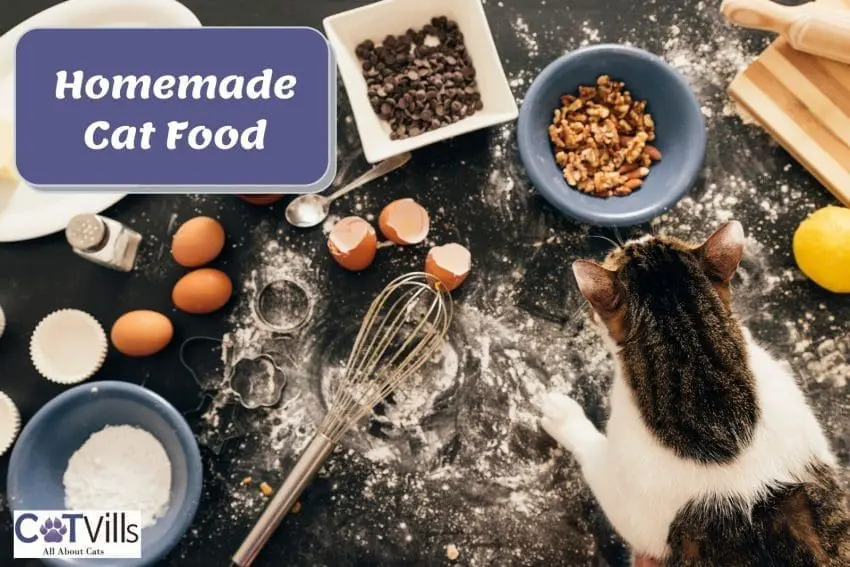
One of the biggest mistakes most cat owners make is subscribing to any diet without considering whether it’s a balanced diet.
You’ll see a wide range of modified diets online, and pet owners probably don’t know they are harming their pets.
That’s why it’s always a good idea to look for a balanced, commercial diet.
According to veterinarian Lisa A. Pierson, the best approach to a homemade meal is to get as close as you can to the diet they feed on in the wild without compromising their health.
What Nutrients Do Cats Need?
Below are the nutrients healthy cat food should contain.
- Animal Protein: Cats get most of their proteins and amino acids, such as taurine, from animals such as chickens or fish or animal products such as eggs.
- Fatty acids: Cats need essential fatty acids for their energy and the intake of Vitamins A, D, E, and K. Some of these essential fatty acids include omega 3 and omega 6.
- Carbohydrates: Carbohydrates are not necessary for a cat’s diet, but they are an excellent alternative energy source. Wheat and rice are some sources of carbs for cats.
- Water: Cats need water to keep them hydrated, to facilitate the transfer of nutrients within their bodies, regulate body temperature, and get rid of toxins.
- Vitamins: Vitamins A, D, B1, B2, B3, and B6 are the essential vitamins cats should get from their diets.
- Minerals: All animals need minerals to facilitate oxygen distribution, maintain ideal pH levels, and enhance nutrient uptake and utilization.
Some of the minerals cats need include calcium, iron, magnesium, sodium, and chloride.
What’s Wrong With Commercial Cat Food?
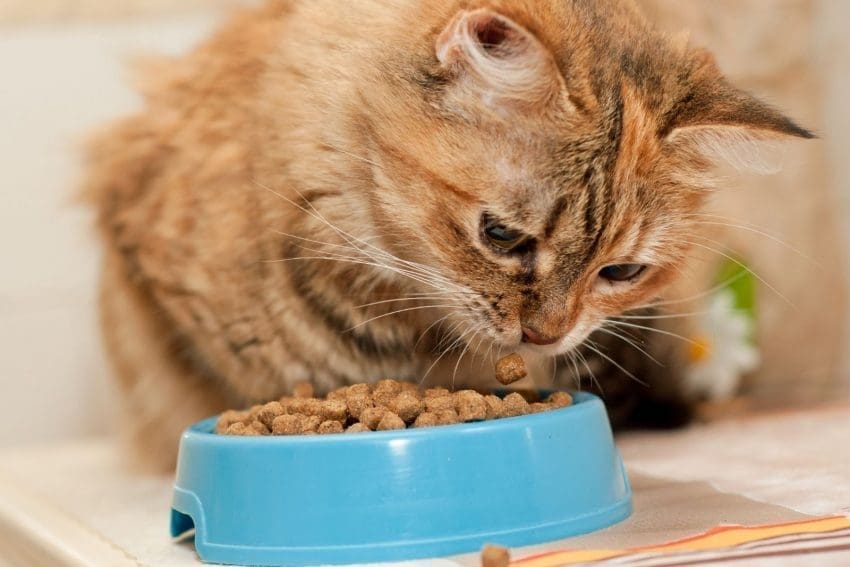
Don’t get me wrong, the reason for suggesting homemade food for cats is not to bash commercially made food.
These foods have been a lifesaver since cats have lost their ability to synthesize taurine, retinol (Vitamin A), and arachidonic acid.
This is because these nutrients were commonly found in their natural diet.
Even though cats are obligate carnivores, feeding cats an animal-based diet to replicate their natural diet can be pretty expensive, and that’s where commercial foods come in.
To achieve all the nutrients a cat needs, they derive some of the nutrients from plants and synthetic vitamin supplements.
For the most part, these diets have been meeting nutrient needs.
However, there have been reports about adverse allergic reactions to these foods, their association to urinary tract diseases, skin diseases, poor coats, and in worst-case scenarios, Inflammatory Bowel Disease, and weight loss.
There have also been cases of nutrient deficiencies in some foods.
These issues make cat owners want to prepare the food themselves since it gives them more control on what to include and what not to include in the diet.
5 Benefits of Raw Cat Food

Cats were domesticated from the wild, so their ancestors fed on raw meat all the time.
That’s why it would make sense if you chose to stick to the raw food path.
Below are some benefits some cat owners have reported after feeding their pets a raw diet:
1. They Poop Less And With a Manageable Odor
According to Margaret Gates, author at feline-nutrition.org, a cat’s digestive system is designed to digest raw food.
So they’ll digest most of the food you feed them, and not much of it will go to waste.
According to a study, cats fed a raw diet have a higher quality stool than those fed commercial diets.
On the other hand, commercial food may contain plant-based nutrients and other additives which your cat’s digestive system may not be well-equipped to digest.
This may eventually lead to more and “disgusting” poop.
2. Improved Dental Health
As cats chew on the bones and raw meat, fewer materials remain between their teeth than when they feed on Kibble or wet cat food.
Cleaner teeth means fewer dental issues.
3. Healthy And Smooth Coats
There’s limited scientific evidence on how a raw diet improves a cat’s skin.
However, most cat owners have reported a tremendous change once they started feeding them a raw diet.
One of the reasons your cat may have an unhealthy coat is because they have an allergic reaction to some ingredients in commercial cat food.
Since these ingredients aren’t in raw food, you will notice a change. Dry cat food is also known to contain less water which may lead to dehydration.
Raw meat is about 60% water which keeps the cat’s skin hydrated and healthy. Wet food may contain more water, but not as much as you’ll find in raw food.
4. Improved Energy Levels
Once a cat feeds on the proper nutrients, they feel energetic to play around.
If they don’t get enough of the essential nutrients, they may seem lazy or lethargic.
5. Maintain a Healthy Weight
Raw cat food is primarily proteins, so cats don’t have to eat a lot of it to meet their nutritional needs.
Since proteins make them more physically active, cats on a raw diet are more likely to be “in shape”.
On the other hand, if your cat doesn’t get enough nutrients from commercial pet food, they may overeat in an attempt to compensate for the missing nutrients.
3 Disadvantages of Raw Cat Food
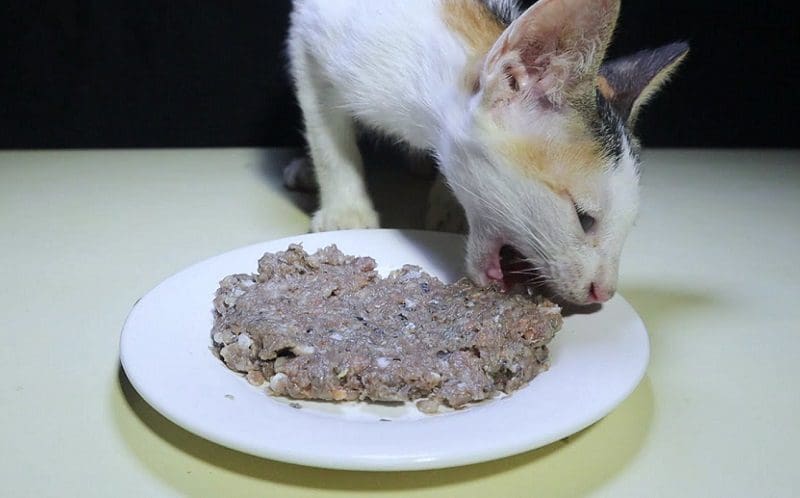
Below are some risks associated with raw cat food.
1. Nutrient Deficiency
It’s still challenging to meet the cat’s nutrient needs with raw meat since all animal products have different nutrient levels.
For instance, if you found chicken liver today and egg yolk tomorrow or fed one of these products exclusively, it may lead to an unbalanced diet.
Also, even though hearts provide taurine, chicken hearts don’t contain as much taurine as they would get from wild prey.
2. Bacteria
Raw meat contains bacteria that may be harmful. That’s why humans adopted the habit of cooking meat to kill some of these bacteria.
According to the American Animal Hospital, even though the bacteria don’t make your cat ill, the cats will excrete it.
Eventually, it may end up causing bacterial contamination to vital items in your house, such as children’s toys, floors, or even kitchenware.
However, according to Lisa A. Pierson, if you’re aware of the source of the meat, you can mitigate the effects of bacteria.
According to her, raw meat that’s frozen immediately after slaughtering contains little to no bacteria and can be fed raw.
On the other hand, meat kept in a refrigerator could still contain bacteria and should be semi-cooked before feeding your cats.
3. Disease Transmission
When you feed your cats a raw diet, you risk transferring some diseases and toxins from these animals to the cat and even to your household.
Simple Recipe for Cat Food
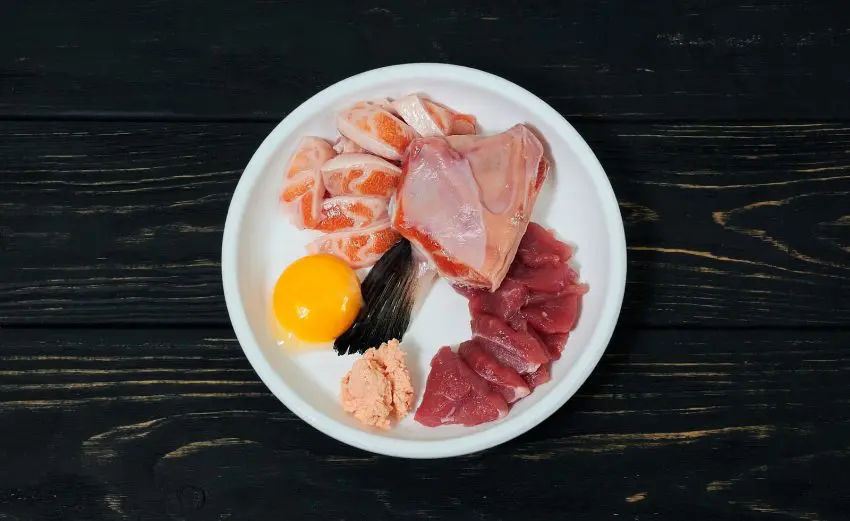
Below are some of the tools you’ll need to prepare a raw cat meal.
- A meat grinder or food processor
- Glass jars
- Digital scale
- Cutting board
- Meat shears
- Meat knives
Below is a summary of a recipe developed by Lisa A. Pierson;
Ingredients
Lisa recommends chicken or rabbit in her diet.
For this recipe, you can either choose 3 lbs. of poultry (including the skin, bone, and thigh meat) or combine 2.25 pounds of ground rabbit and at least 1 lb. of poultry.
Below are other items to include:
- 1 cup of water
- 2 eggs (raw yorks and half-cooked whites)
- 5000 to 10,000 mg fish oil – preferably fish oil capsules 5-10 capsules).
- 268 mg Vitamin E
- 2000 mg taurine
- 1 capsule Vitamin B-Complex 50
- 1 tbsp. Morton Lite salt with iodine for all chicken, or ½ tbsp. When using both rabbit and chicken.
- Liver when dealing with chicken (god source of Vitamin A). Some sellers include liver in-ground rabbit, so you don’t have to include it.
Instructions
Ground rabbit:
- When dealing with ground rabbit, use a grinder to prepare the chicken and mix it with the rabbit meat. If you received the meat when it’s frozen, thaw it first before preparing it.
- Mix all the supplements I mentioned above and add this supplement slurry into your meat mixture and mix thoroughly. You can use your hands to mix if you’re preparing a lot of food.
Chicken (baking option):
- Bake the chicken till it’s 50% cooked under 350 degrees. The oil extracted from baking should be added to the eggs, liver, or any other organs I mentioned in the recipe.
- Cook the liver for at least 20 minutes and break it up to make sure it’s all cooked.
- Cut the raw meat into smaller chunks and remove the bones.
- Run the liver, eggs, and larger pieces of meat in the grinder and refrigerate the mixture as you prepare the supplement slurry.
- Once the slurry is ready, mix it in the meat mixture and store the thawed mixture in a refrigerator for up to 72 hours, leaving some headspace for expansion.
- After 72 hours, this mixture is ready for storage in smaller cans. Select a container size based on the number of cats you have and how long you need each container to last.
This food is enough to feed your cat for up to 15 days. Better yet, this food is even safe for human consumption.
Benefits Of Cooked Cat Food
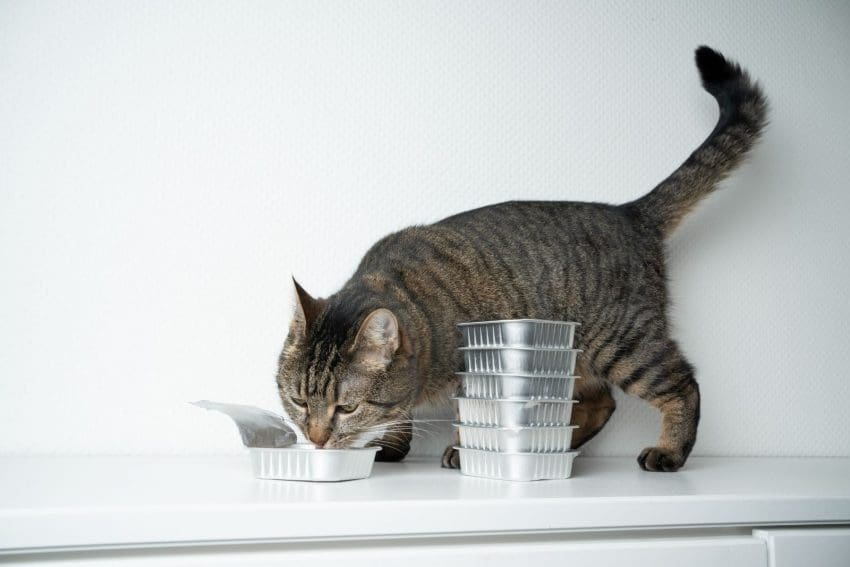
Cooking cat food involves mixing different ingredients, both meat and plant-based, to meet your cat’s nutrient needs.
There isn’t much scientific study to support or go against cooking cat food. But below are some benefits of cooked cat food.
Control on The Ingredients
As mentioned earlier, cats may be allergic to some of the ingredients in some commercial cat foods.
Others may not like a particular food at all.
When preparing food for your cat, you have the freedom to include what your cat likes and eliminate any ingredients that may be harmful.
It Saves Time
Preparing cat food might seem time-consuming at first, and it is.
However, you only need to do it a few times month. And when you do it, you prepare lots of it and store it in a freezer.
Cost-Efficient
Whether you’re serving your cat raw food or cooked food, you may end up saving some money compared to buying ready-made food.
At first, you may need to invest upfront to get the food processor and other necessary equipment, but it will cut down the food costs in the long run.
If the health benefits are anything to go by, this saves you numerous trips to the vet.
Disadvantages of Cooked Cat Food
The only concern about cooked food is quality control, where some cat owners fail to achieve a balanced diet with the ingredients.
However, Rebecca Remillard, a veterinarian, notes that as long as cat owners meet the necessary nutrient needs in the food they prepare, there’s nothing wrong with cooking cat food at home.
Sample Cooked Cat Food Recipe
Below is a recipe suggested by MSPCA-Angell Animal Medical Center and approved by Dr Remillard.
It would help if you had a scale to make sure you get all the food amounts right.
- 83 gm. Animal protein (cooked) – Some good protein sources include chicken, dark meat, salmon, and lamb.
- 50 gm. (1/3 cup) carbohydrates (cooked) – wheat or rice
- 30 gm. (1/5 cup Fiber – potatoes or sweet potatoes, cooked and without the skin.
- 2.7 gm. Balance IT Feline.
- The cooking process involves mixing all of these ingredients.
This is enough food for an adult cat weighing up to 12 pounds. You can feed your pet small amounts throughout the day and make sure you warm the food.
MSPCA-Angel Animal Medical Center recommends heating frozen food with a microwave.
However, this could lead to overheating some sections of the food. To avoid this, you can warm the food by placing it in warm water or running cold water.
FAQs
Is a homemade diet better for cats?
Yes, it is. A raw diet has proved to improve digestion, energy levels, and skin health. You also have more control over what to feed and what not to feed your cat.
Is it cheaper to make homemade cat food?
Yes, it’s relatively cheaper. It may be a bit expensive to start, but you prepare food your cats can eat for a long time, making it economical in the long run. Cats on a homemade diet are also healthier, minimizing treatment costs you could have incurred with other diets.
Can you combine homemade food and Kibble?
It’s not a good idea. The main reason one would recommend homemade food is to do away with commercial dry food due to the issues associated with it. So, mixing both would be superfluous.
Final Thoughts
And there you have it. Going for homemade cat food is a good idea since you’re certain what foods you’re feeding your cat.
While raw foods and cooked foods are pitted against each other, they shouldn’t. We think you’d achieve healthy cat food if you combined both.
It’s also important to contact your vet before trying any cat food diet, especially if your cat suffers from mild or chronic illnesses. A cat’s nutrient profile may differ due to health, age, or even weight.
And even though a homemade diet promises to be healthier than commercial food, regular vet checkups are still necessary since not all diseases result from a poor diet.
Have you tried making homemade cat food? Share with us your experience below!
Resources:

